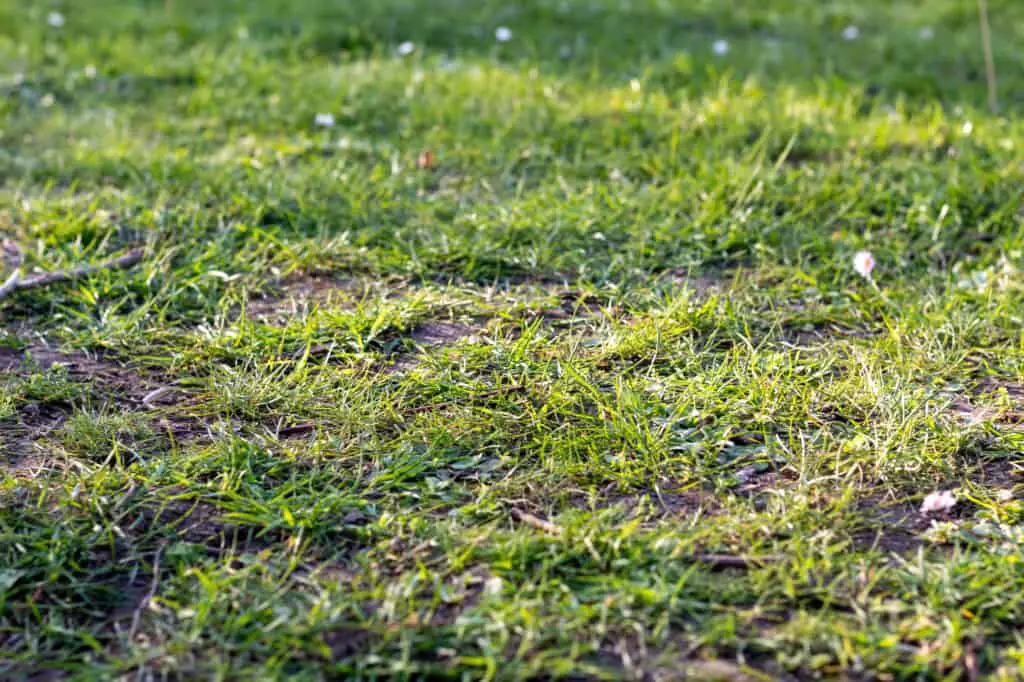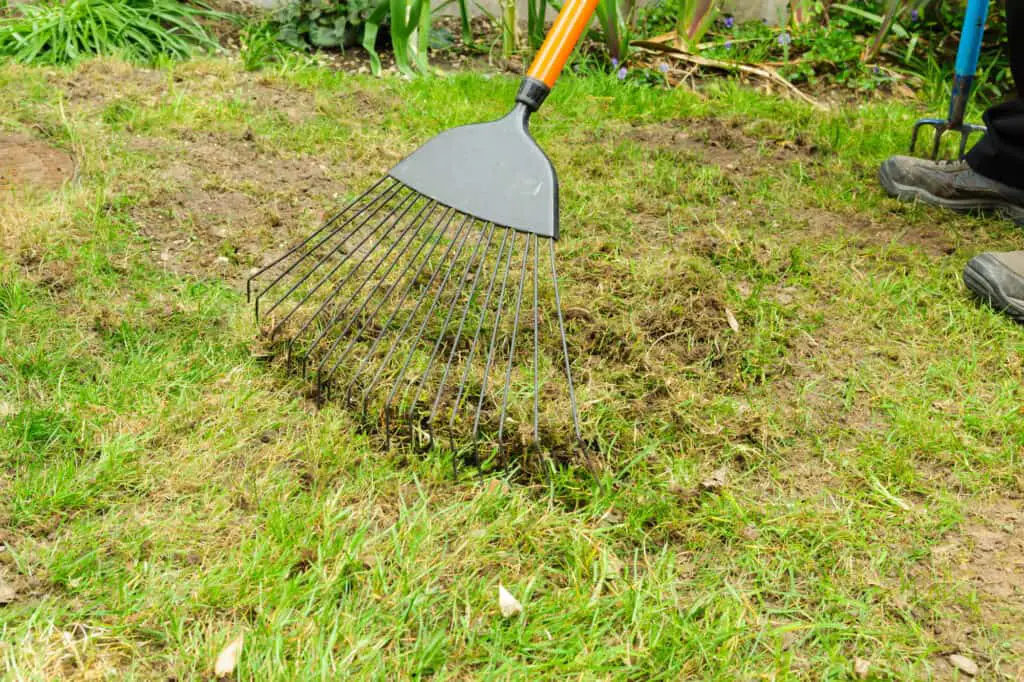Moss Removal And
The Best Moss Killer For Lawns
If you’re a homeowner, you know that moss is a common problem for lawns. If you’re struggling to remove moss from your lawn, you’re in the right place. In this guide, we’ll share some effective tips and tricks to get rid of moss in your lawn and all you need to know about moss control, leaving you with a fabulous garden to enjoy.
There are 18 different types of moss found in peoples gardens up and down the UK, however only a few are found in lawns. The good news is that they are all tackled in the same way.

Raking / Scarifying: A Preferred Method
Raking is the most popular method for removing moss from your lawn. For small lawns, you can use a wire ‘spring bok’ or ‘fan rake’. However, for larger lawns, a powered lawn raker or scarifier with wire tines would be more efficient. Hand lawn scarifiers are also available and work well for small to medium-sized lawns.

The Importance of Timing and Lawn Recovery
During April and again during September, moss produces spores which can lead to an increase in moss growth. If possible, it is advisable to remove or kill the moss before it begins to spore. This normally means raking the lawn early in April to avoid the spores from forming.
In order to achieve the best results, you’ll want to wait until the weather has warmed up, so that the grass has time to heal itself. You’ll also want to make sure that there is sufficient moisture and fertilizer available.
Similarly, if you wait until it rains in autumn, you’ll stimulate moss to grow, but you’ll also provide moisture to your lawn in order to recover. As a matter of fact, if you plan on performing any “invasive” treatment on your lawn, you’ll need to ensure it can recover and repair itself quickly. If it doesn’t, you’ll have weed problems replaced by moss problems.
Some people are concerned that raking may spread the moss and make the problem worse. However, moss infestation is a common problem that affects many lawns. Moss killers are commonly applied and then dead moss is raked out.
Here are some things to consider when dealing with a moss problem:
- Unless the lawn is already completely covered in moss, raking is unlikely to spread it to new areas because moss spreads by releasing spores.
- When using a moss killer, either granular or liquid, you will not completely kill all the moss. It is possible that some of it may be embedded too deeply for the treatment to penetrate all the way through.
- There is a possibility that raking after the moss killer is applied may cause the remaining live moss to spread, which would be somewhat counterproductive to the purpose of the moss killer in the first place.
The following steps can be used as an alternative method of removing moss from your lawn:
- Do your best to remove as much of the moss as you can, but don’t worry if you cannot get all of it out.
- In order to kill the remaining moss, spray a moss killer over it after you have raked the lawn. This will thin out the moss and make it easier for the moss killer to penetrate and kill it. This method can eliminate 90% or more of the moss.
List Of Products that will Kill Moss in Lawns:
Anything that contains Ferrous Sulphate which is the same as Iron Sulphate will kill moss. Please be aware that products used for killing moss are completely different to lawn weed killers. They are designed for different functions.
The best moss killer for lawns are any of the following products, they all do roughly the same thing. Just double check how to apply them. Some you can just sprinkle on your lawn whilst others need to be mixed with water first and then sprayed on.
Guard En Force Iron Sulphate
Pro-Kleen Iron Sulphate
Here is a before and after photo of the results after using Pro-Kleen

EverGreen Complete 4-in-1 Lawn Care (Miracle Gro)
Here is a before and after photo of my garden after I used this product

The Evergreen products come with a built in spreader, this makes it super easy to use.
Greenforce 4-in-1
The product below will just kill moss and not provide any other benefit to your lawn.
All the above mentioned products will remove moss, fertilize your lawn and help produce a greener and hardier lawn for everyone to enjoy.
VivaGreen MossOff
There is a DIY method to remove moss from your lawn and that’s Baking Soda, so if you have some lying around at home you can just use it. How do you use it? Simply add three tablespoons of baking soda to 1 litre of water and spray the mixture onto the desired location.
Baking Soda (Sodium Bicarbonate)
Moss Removal Tips:
Applying a lawn moss killer before raking has the added benefit of desiccating the moss to some degree, reducing its bulk. If the moss problem is severe enough, you may want to consider applying a moss killer both before and after raking. However you need to wait a few weeks before applying the second treatment.
If you plan on applying ferrous sulphate, iron sulphate or MossOff before raking, do so 7 to 14 days in advance.
The application of ferrous sulphate (same thing as iron sulphate) works better if conditions are damp, so if they’re dry, lightly sprinkle the lawn with water before applying.
However MossOff requires dry conditions. A light high topping with the mower beforehand can aid penetration, regardless of which product you choose.
Because moss products acidify the soil, it’s crucial to apply them uniformly over the entire lawn. Otherwise, you risk creating pH variations that can affect grass growth and even increase moss infestations in the future.
In order to remove the moss, one of the best ways is to rake a dry day, usually in April to early May, when the grass is actively growing (or in late August or early September if you are raking now). Mow the lawn before raking so that the moss is exposed better and the resistance on the rake may be reduced.
When using ferrous sulphate after raking, it is best to apply it as soon as possible after raking and to remove any debris first, consider using a rotary mower to get the last few bits out. When spraying before and after, timing is very important. The grass may be damaged if you apply high doses of ferrous sulphate within four weeks of each other. In order to prevent this from happening, spray the grass three weeks before raking and re-spray one week afterward.
How To Prevent Moss In The First Place Or Moss From Coming Back
1. Soil acidity should be maintained
Your lawn grass should have a pH level between 6 and 7. You can check the acidity level of your soil with a soil test kit, which measures the acidity level. When the pH level is low, the soil is acidic. If the pH level is high, the soil is alkaline. Lime is a well-known trick for reducing soil acidity.
2. Check the moisture of the soil
In addition to measuring the acidity of your soil, you should also check the moisture level. If the soil is too wet, you will be able to encourage the growth of moss. When the soil is too dry, it causes plants and grass to die, which gives moss a chance to flourish, since it is a resilient species. You can use a rain gauge to monitor the water levels of your soil, and you will be able to determine whether additional water or drainage is required to make the soil healthy.
3. Soil should be fertilized
The lack of nutrients in your soil is one of the most common causes for grass to die and moss to take over. You can fix this problem by fertilizing your soil with organic waste in order to improve its quality and nutrient content.
4. Reduce the amount of shade
You should cut back trees or remove things that block your grass from getting enough sunlight in order to reduce the growth of moss. As this might not always be possible, you might also consider growing grass species that can tolerate the shade.
5. Your lawn needs to be scarified
The compacted soil in the lawn prevents grass from absorbing the nutrients it needs, but moss can still thrive there because of the lack of nutrients. You can combat compacted soil on your lawn by aerating and scarifying it from time to time throughout the year.
